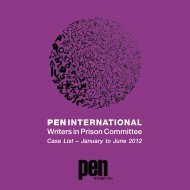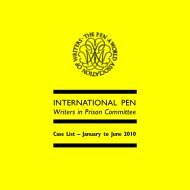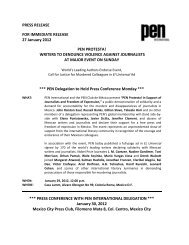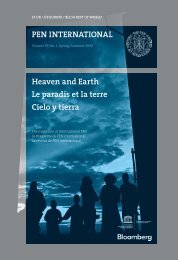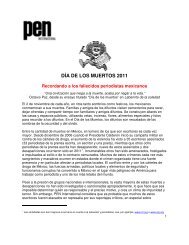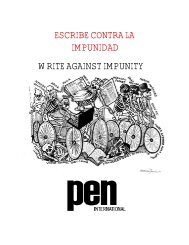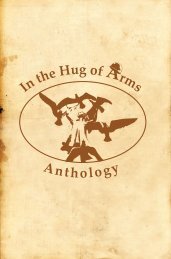Sierra Leone Junior PENPoint Magazine - Pen International
Sierra Leone Junior PENPoint Magazine - Pen International
Sierra Leone Junior PENPoint Magazine - Pen International
Create successful ePaper yourself
Turn your PDF publications into a flip-book with our unique Google optimized e-Paper software.
<strong>Junior</strong> <strong>Pen</strong> Point <strong>Magazine</strong> May 2008 Page 14<br />
Elements of Creative Writing For Children<br />
BY MRS T. A LUCAN<br />
Writing is an Art. Anything<br />
that is creative is an Art.<br />
Creative Writing therefore is an<br />
Art in a double sense, and anyone<br />
who engages in it can lay<br />
claim to being in the domain of<br />
the Artist. Whatever activity<br />
one engages in for the benefit<br />
of children, be it their feeding,<br />
or their education or just their<br />
welfare, must be carefully<br />
handled and when it comes to<br />
writing for them this must be<br />
artistically done. Before going<br />
on to the subject of this paper,<br />
permit me to dwell a little on<br />
the creative writer, the Artist<br />
himself or herself. I shall ask<br />
three questions.<br />
1. Your Inclination – when did<br />
you become aware of your inclination,<br />
or tendency towards creative<br />
writing for children? Was<br />
it just when you saw the advert<br />
for entries and the prizes being<br />
offered for the competition or<br />
has there been a long-standing<br />
urge to express yourself in<br />
words on paper. Of course I know<br />
that in fact some of you have<br />
been writing for some time. But<br />
it is the art of writing for a specific<br />
audience that is the problem.<br />
You must put yourself in<br />
the place of your target audience,<br />
in this case children- the<br />
age group concerned.<br />
2. Motivation - Assuming that<br />
you had or have always had an<br />
inclination or tendency towards<br />
writing, what then motivated<br />
you to actually write? It could<br />
have been your association with<br />
children in the home, at school<br />
or in society. Perhaps it was<br />
something you heard in a taxi<br />
or saw on Television. Something<br />
triggered off a passionate<br />
feeling or some irresistible urge<br />
for you to write. Perhaps you<br />
woke up in the middle of the<br />
night, seized by an inspiration<br />
resulting in an idea.<br />
3. The Idea – what did you do<br />
about the idea you had? Did you<br />
scribble it down as it came to<br />
you? Once you get an idea, it is<br />
best to jot it down, then develop<br />
it fully in your mind, before you<br />
begin to write. Remember that<br />
the most difficult materials to<br />
present is that which is intended<br />
for children, whether fiction<br />
or non-fiction. Says an Indian<br />
writer of folk tales for children<br />
“I had to bring a certain<br />
mobility and action into these<br />
art forms which are usually<br />
static. This I thought would give<br />
the children greater involvement<br />
and interest in the story<br />
and ensure that they would<br />
want to travel from page to<br />
page.”<br />
Now let us look at the elements<br />
in creative writing. Let<br />
me say that these elements<br />
apply to creative writing for<br />
any audience, but here we are<br />
concerned with children.<br />
These elements are:-<br />
1. The Characters<br />
In developing an idea, the<br />
writer needs characters- the<br />
persons or objects which would<br />
give life and meaning to the<br />
idea. Here it is necessary to<br />
create believable characters. If<br />
the central character is a child<br />
let him/her come out as real<br />
person. It makes no difference<br />
if the character is human or<br />
animal, a devil or a ghost; it<br />
should be believable even by<br />
children. Kunny Rabbit must<br />
really perform believable tricks.<br />
The main characters must always<br />
initiate action.<br />
Children love characters with<br />
whom they can identify so the<br />
writer should know his characters<br />
well and describe them<br />
clearly enough to be recognized<br />
by the child. Choose their<br />
names carefully. Make them<br />
easy to remember.<br />
2. THE PLOT<br />
A plot tells what happens to the<br />
characters in a story. It is build<br />
around an event or a series of<br />
events which take place within<br />
a given time. A story might begin<br />
with a background which<br />
builds up to a climax the highest<br />
point of the story leaving the<br />
reader asking “what happens<br />
next?” the answer comes in the<br />
outcome at the end of the story.<br />
Children like stories in which<br />
exciting things happen. They<br />
do not like stereotypes<br />
3. THE THEME<br />
If you are an avid reader as you<br />
should be, you would realize that<br />
every good story leaves an emotional<br />
feeling in your mind-love<br />
, hate, fear, joy, envy, hope or<br />
something. It need not be a<br />
clear message or a moral, but<br />
what develops from the interplay<br />
of the characters and the plot.<br />
Even in creative writing for children,<br />
however young, there<br />
must be a theme which would<br />
evoke some emotion.<br />
4. THE STYLE<br />
The way you present your story<br />
is very important. You may<br />
wish to begin with the usual “ilow-wan<br />
de yah” or “once upon a<br />
time”, these are customary beginnings,<br />
but you may choose<br />
your own style- get off to a cracking<br />
start- especially for the upper<br />
primary. Use dialogue skillfully,<br />
bring in dramatic scenes,<br />
and some humor where appropriate.<br />
A story may be written in the first<br />
person as though the writer is the<br />
principal character or in the third<br />
person where the writer stands<br />
apart from the characters and tells<br />
the story. This is usually preferred<br />
by beginning writers.<br />
In conclusion, you may now look<br />
at your entry in the light of the<br />
elements of (1) character (2) plot<br />
(3) theme and (4) style and see<br />
whether you can do an analysis<br />
to find out where the weaknesses<br />
lay.






